Abstract
The Caenorhabditis elegans vit genes, encoding vitellogenins, are abundantly expressed in the adult hermaphrodite intestine. Two repeated elements, vit promoter element 1 (VPE1 [TGTCAAT]) and VPE2 (CTGATAA), have been identified in the 5' flanking DNA of each of the vit genes of C. elegans and Caenorhabditis briggsae. These elements have previously been shown to be needed for correctly regulated expression of a vit-2/vit-6 fusion gene in low-copy-number, integrated transgenes. Here we extend the analysis of the function of VPE1 and VPE2 by using transgenic lines carrying large, extrachromosomal arrays of the test genes. The results validate the use of such arrays for transgenic analysis of gene regulation in C. elegans, by confirming previous findings showing that the VPE1 at -45 and both VPE2s are sites of activation. Additional experiments now indicate that when the -45 VPE1 is inverted or replaced by a VPE2, nearly total loss of promoter function results, suggesting that the highly conserved -45 VPE1 plays a unique role in vit-2 promoter function. In contrast, single mutations eliminating the three upstream VPE1s are without effect. However, in combination in double and triple mutants, these upstream VPE1 mutations cause drastic reductions in expression levels. The -150 VPE2 can be replaced by a XhoI site (CTCGAG), and the -90 VPE2 can be eliminated, as long as the overlapping VPE1 is left intact, but when these two replacements are combined, activity is lost. Thus, the promoter must have at least one VPE2 and it must have at least two VPE1s, one at -45 and one additional upstream element.
Full text
PDF
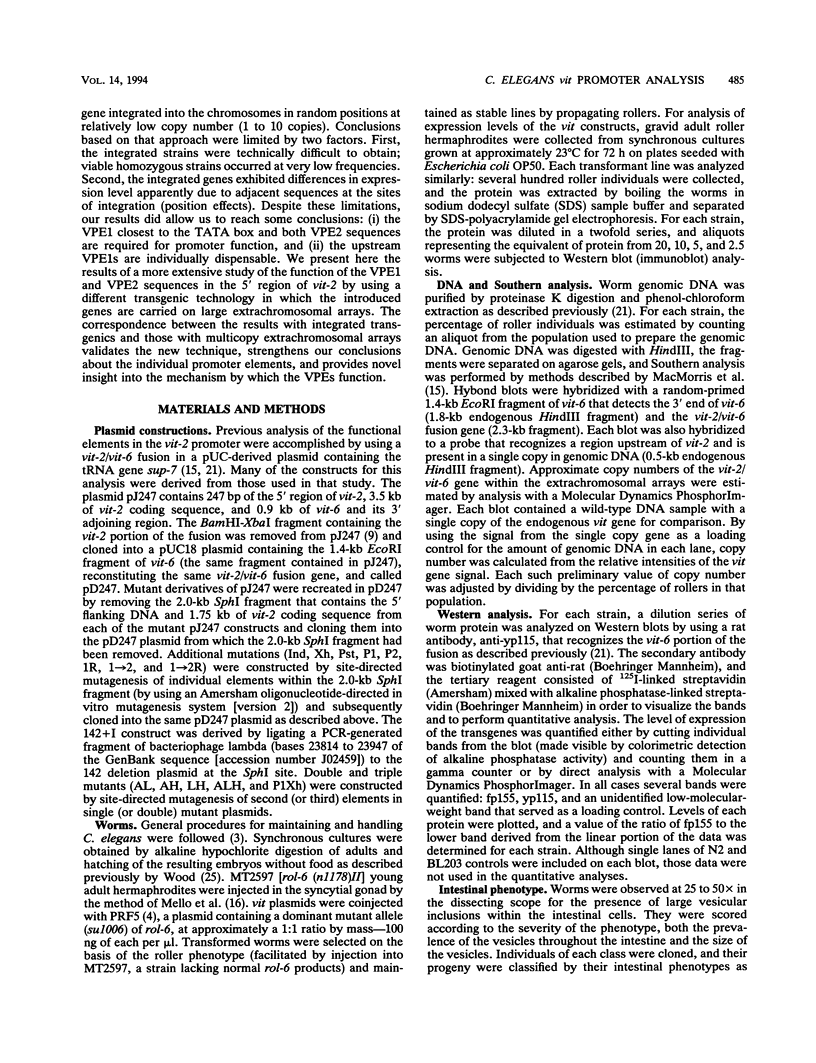
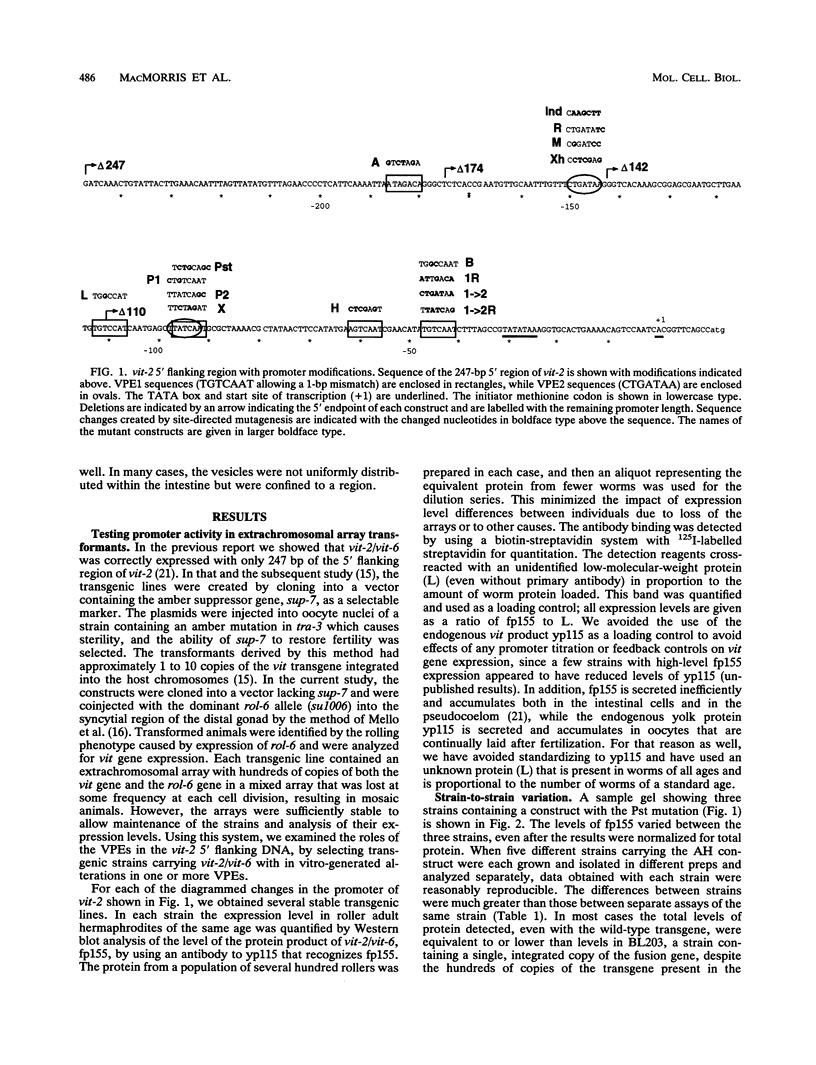
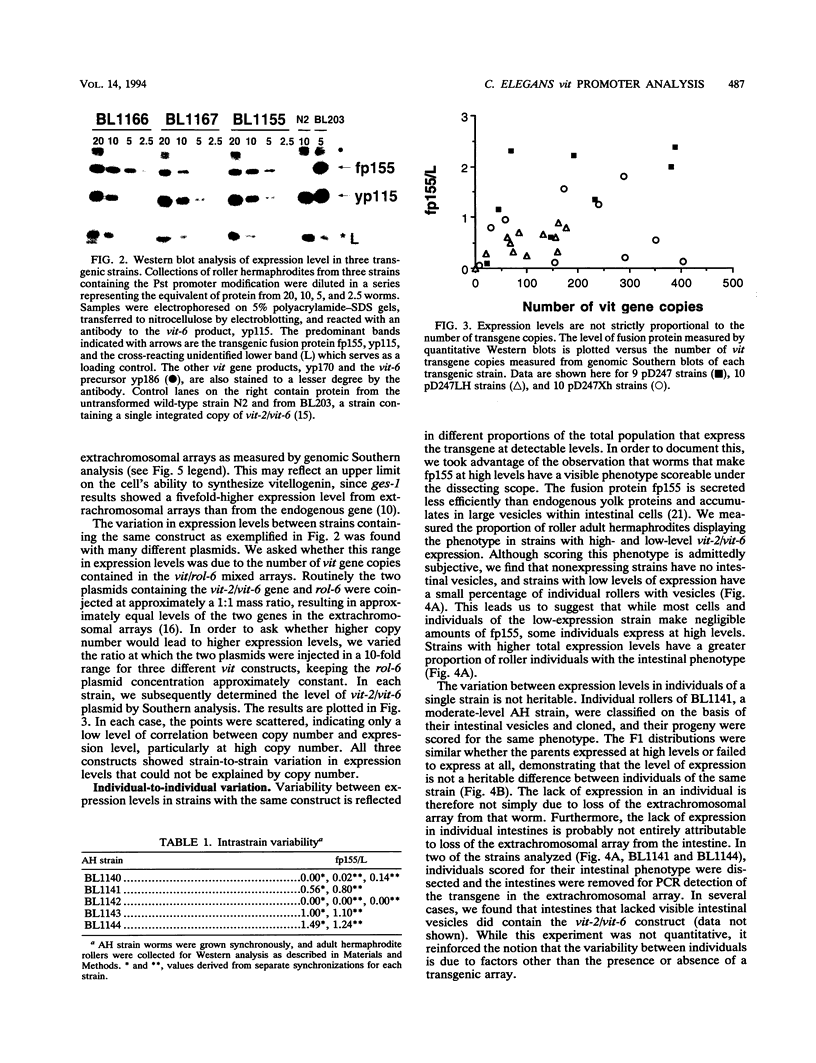
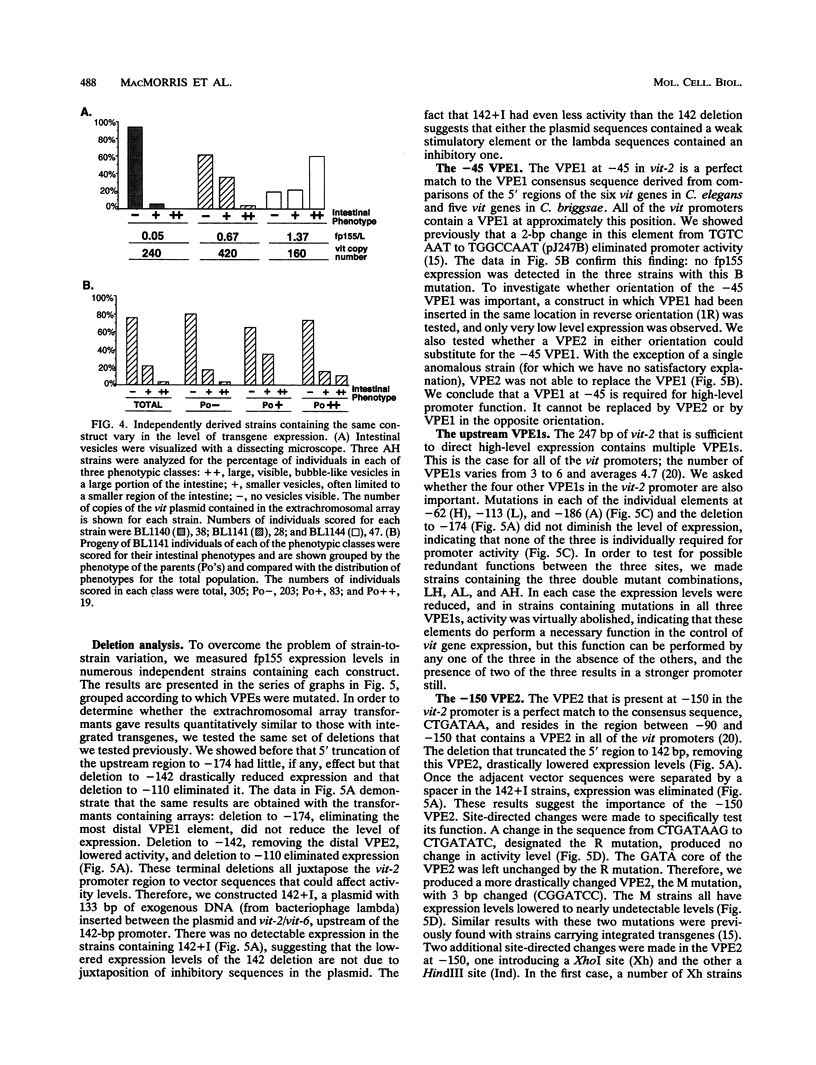
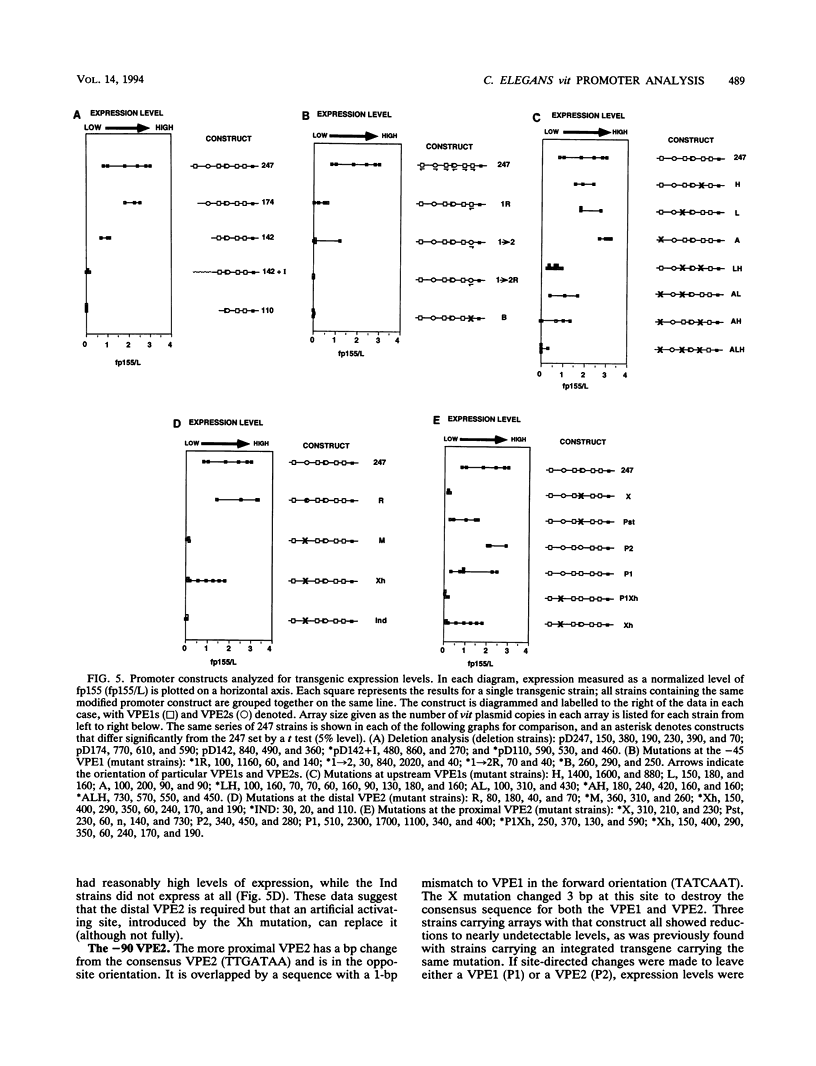
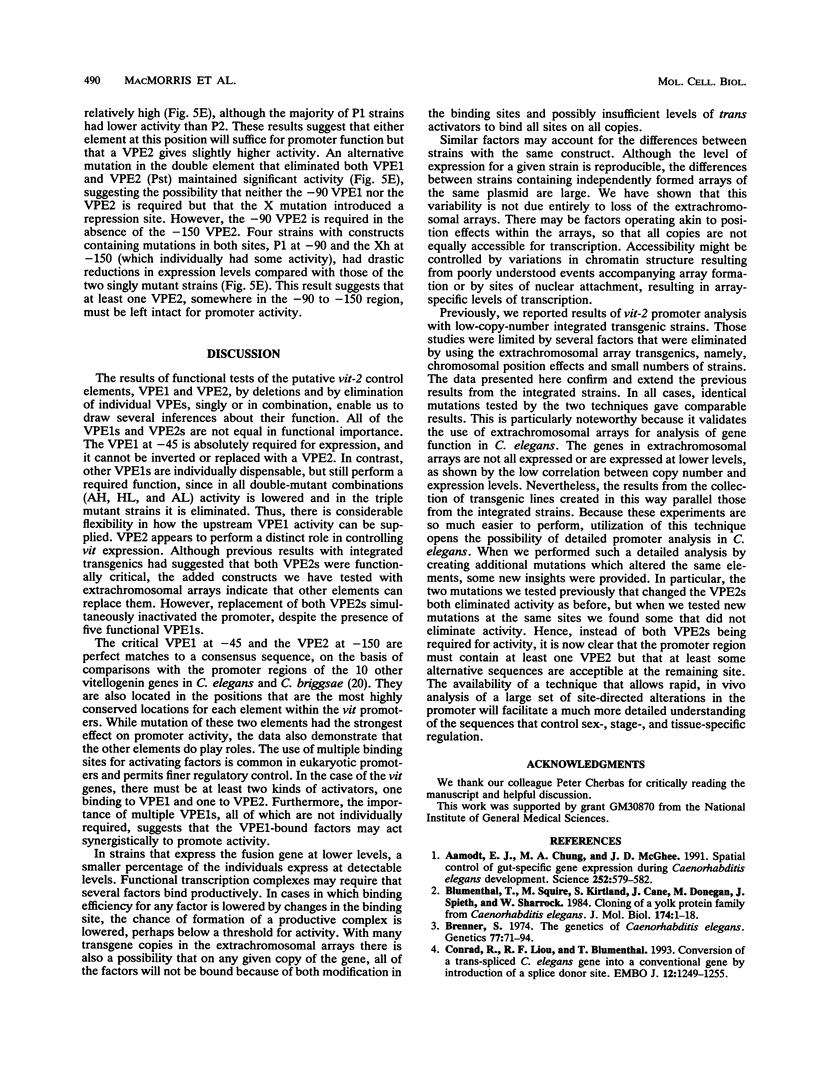
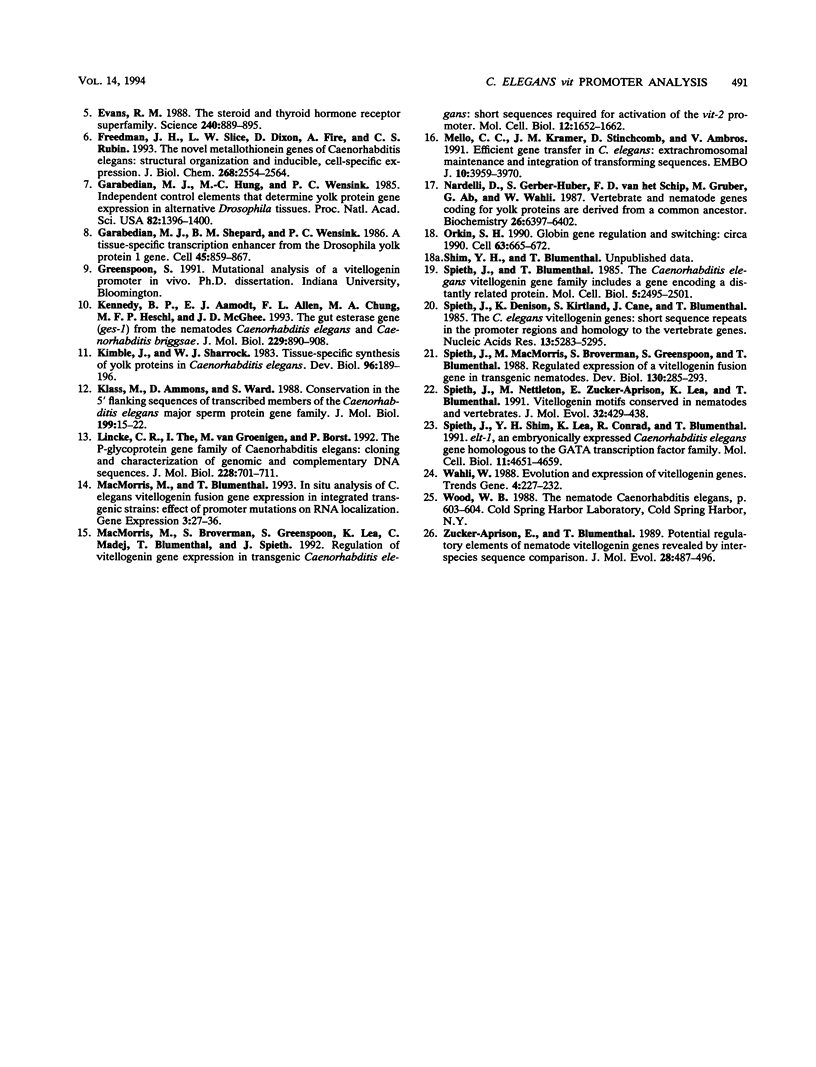
Images in this article
Selected References
These references are in PubMed. This may not be the complete list of references from this article.
- Aamodt E. J., Chung M. A., McGhee J. D. Spatial control of gut-specific gene expression during Caenorhabditis elegans development. Science. 1991 Apr 26;252(5005):579–582. doi: 10.1126/science.2020855. [DOI] [PubMed] [Google Scholar]
- Blumenthal T., Squire M., Kirtland S., Cane J., Donegan M., Spieth J., Sharrock W. Cloning of a yolk protein gene family from Caenorhabditis elegans. J Mol Biol. 1984 Mar 25;174(1):1–18. doi: 10.1016/0022-2836(84)90361-9. [DOI] [PubMed] [Google Scholar]
- Brenner S. The genetics of Caenorhabditis elegans. Genetics. 1974 May;77(1):71–94. doi: 10.1093/genetics/77.1.71. [DOI] [PMC free article] [PubMed] [Google Scholar]
- Conrad R., Liou R. F., Blumenthal T. Conversion of a trans-spliced C. elegans gene into a conventional gene by introduction of a splice donor site. EMBO J. 1993 Mar;12(3):1249–1255. doi: 10.1002/j.1460-2075.1993.tb05766.x. [DOI] [PMC free article] [PubMed] [Google Scholar]
- Evans R. M. The steroid and thyroid hormone receptor superfamily. Science. 1988 May 13;240(4854):889–895. doi: 10.1126/science.3283939. [DOI] [PMC free article] [PubMed] [Google Scholar]
- Freedman J. H., Slice L. W., Dixon D., Fire A., Rubin C. S. The novel metallothionein genes of Caenorhabditis elegans. Structural organization and inducible, cell-specific expression. J Biol Chem. 1993 Feb 5;268(4):2554–2564. [PubMed] [Google Scholar]
- Garabedian M. J., Hung M. C., Wensink P. C. Independent control elements that determine yolk protein gene expression in alternative Drosophila tissues. Proc Natl Acad Sci U S A. 1985 Mar;82(5):1396–1400. doi: 10.1073/pnas.82.5.1396. [DOI] [PMC free article] [PubMed] [Google Scholar]
- Garabedian M. J., Shepherd B. M., Wensink P. C. A tissue-specific transcription enhancer from the Drosophila yolk protein 1 gene. Cell. 1986 Jun 20;45(6):859–867. doi: 10.1016/0092-8674(86)90560-x. [DOI] [PubMed] [Google Scholar]
- Kennedy B. P., Aamodt E. J., Allen F. L., Chung M. A., Heschl M. F., McGhee J. D. The gut esterase gene (ges-1) from the nematodes Caenorhabditis elegans and Caenorhabditis briggsae. J Mol Biol. 1993 Feb 20;229(4):890–908. doi: 10.1006/jmbi.1993.1094. [DOI] [PubMed] [Google Scholar]
- Kimble J., Sharrock W. J. Tissue-specific synthesis of yolk proteins in Caenorhabditis elegans. Dev Biol. 1983 Mar;96(1):189–196. doi: 10.1016/0012-1606(83)90322-6. [DOI] [PubMed] [Google Scholar]
- Klass M., Ammons D., Ward S. Conservation in the 5' flanking sequences of transcribed members of the Caenorhabditis elegans major sperm protein gene family. J Mol Biol. 1988 Jan 5;199(1):15–22. doi: 10.1016/0022-2836(88)90375-0. [DOI] [PubMed] [Google Scholar]
- Lincke C. R., The I., van Groenigen M., Borst P. The P-glycoprotein gene family of Caenorhabditis elegans. Cloning and characterization of genomic and complementary DNA sequences. J Mol Biol. 1992 Nov 20;228(2):701–711. doi: 10.1016/0022-2836(92)90855-e. [DOI] [PubMed] [Google Scholar]
- MacMorris M., Blumenthal T. In situ analysis of C. elegans vitellogenin fusion gene expression in integrated transgenic strains: effect of promoter mutations on RNA localization. Gene Expr. 1993;3(1):27–36. [PMC free article] [PubMed] [Google Scholar]
- MacMorris M., Broverman S., Greenspoon S., Lea K., Madej C., Blumenthal T., Spieth J. Regulation of vitellogenin gene expression in transgenic Caenorhabditis elegans: short sequences required for activation of the vit-2 promoter. Mol Cell Biol. 1992 Apr;12(4):1652–1662. doi: 10.1128/mcb.12.4.1652. [DOI] [PMC free article] [PubMed] [Google Scholar]
- Mello C. C., Kramer J. M., Stinchcomb D., Ambros V. Efficient gene transfer in C.elegans: extrachromosomal maintenance and integration of transforming sequences. EMBO J. 1991 Dec;10(12):3959–3970. doi: 10.1002/j.1460-2075.1991.tb04966.x. [DOI] [PMC free article] [PubMed] [Google Scholar]
- Nardelli D., Gerber-Huber S., van het Schip F. D., Gruber M., Ab G., Wahli W. Vertebrate and nematode genes coding for yolk proteins are derived from a common ancestor. Biochemistry. 1987 Oct 6;26(20):6397–6402. doi: 10.1021/bi00394a014. [DOI] [PubMed] [Google Scholar]
- Orkin S. H. Globin gene regulation and switching: circa 1990. Cell. 1990 Nov 16;63(4):665–672. doi: 10.1016/0092-8674(90)90133-y. [DOI] [PubMed] [Google Scholar]
- Spieth J., Blumenthal T. The Caenorhabditis elegans vitellogenin gene family includes a gene encoding a distantly related protein. Mol Cell Biol. 1985 Oct;5(10):2495–2501. doi: 10.1128/mcb.5.10.2495. [DOI] [PMC free article] [PubMed] [Google Scholar]
- Spieth J., Denison K., Kirtland S., Cane J., Blumenthal T. The C. elegans vitellogenin genes: short sequence repeats in the promoter regions and homology to the vertebrate genes. Nucleic Acids Res. 1985 Jul 25;13(14):5283–5295. doi: 10.1093/nar/13.14.5283. [DOI] [PMC free article] [PubMed] [Google Scholar]
- Spieth J., MacMorris M., Broverman S., Greenspoon S., Blumenthal T. Regulated expression of a vitellogenin fusion gene in transgenic nematodes. Dev Biol. 1988 Nov;130(1):285–293. doi: 10.1016/0012-1606(88)90434-4. [DOI] [PubMed] [Google Scholar]
- Spieth J., Nettleton M., Zucker-Aprison E., Lea K., Blumenthal T. Vitellogenin motifs conserved in nematodes and vertebrates. J Mol Evol. 1991 May;32(5):429–438. doi: 10.1007/BF02101283. [DOI] [PubMed] [Google Scholar]
- Spieth J., Shim Y. H., Lea K., Conrad R., Blumenthal T. elt-1, an embryonically expressed Caenorhabditis elegans gene homologous to the GATA transcription factor family. Mol Cell Biol. 1991 Sep;11(9):4651–4659. doi: 10.1128/mcb.11.9.4651. [DOI] [PMC free article] [PubMed] [Google Scholar]
- Wahli W. Evolution and expression of vitellogenin genes. Trends Genet. 1988 Aug;4(8):227–232. doi: 10.1016/0168-9525(88)90155-2. [DOI] [PubMed] [Google Scholar]
- Zucker-Aprison E., Blumenthal T. Potential regulatory elements of nematode vitellogenin genes revealed by interspecies sequence comparison. J Mol Evol. 1989 Jun;28(6):487–496. doi: 10.1007/BF02602929. [DOI] [PubMed] [Google Scholar]



